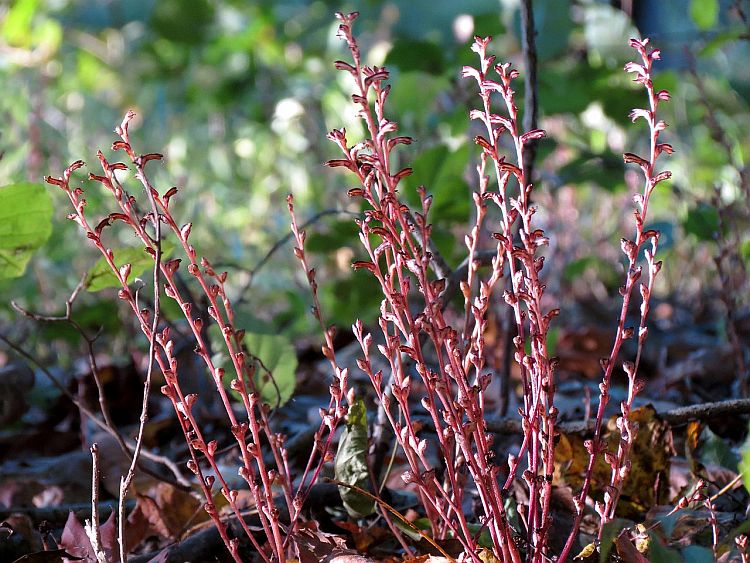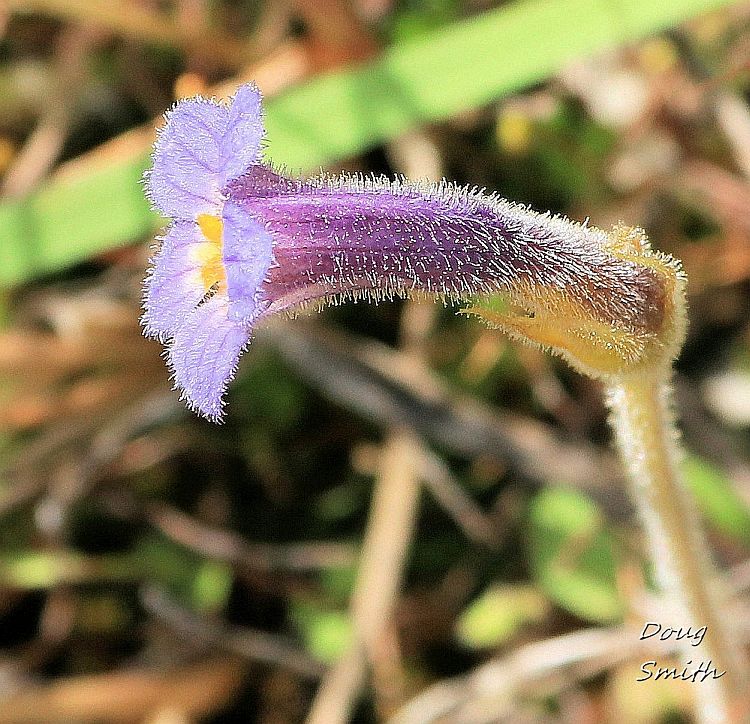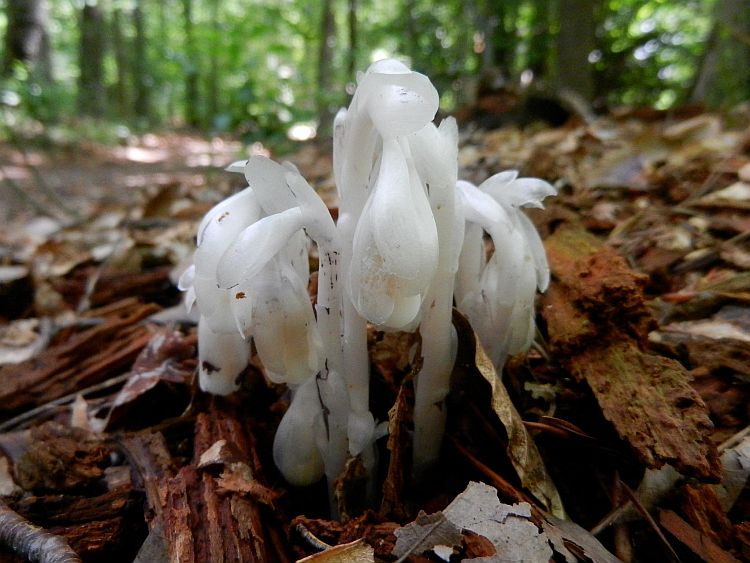A Parasitic Lifestyle: Beechdrops and Their Relatives
By Marion Lobstein
Two primary characteristics of plants are a light-capturing pigment, chlorophyll, which gives most plants a green color, and the use of this pigment to capture light energy to carry out photosynthesis to produce energy-rich food from carbon dioxide and water. This kind of plant lifestyle is known as autotrophic or self-nourishing. Indian Pipe (Monotropa uniflora), a species of flowering plants that lack chlorophyll, is one you may have noticed growing in rich summer woodlands. It is a member of the Ericaceae (Heath family). This ghostly white species is saprophytic, which means it forms a symbiotic relationship with fungi to extract nutrients from dead plant material in the leaf litter or soil.
Parasitic plants
Another way flowering plant species obtain nutrients is to “steal” from a living host. This lifestyle, called parasitic, can be either holoparasitic, where species lack chlorophyll to carry out photosynthesis and depend totally on the host plant; or hemiparasitic, where a species has chlorophyll and is partially photosynthetic but still parasitizes a host plant for part of its nutrients. Three species of holoparasitic plants, members of the Orobanchaceae (Broomrape family), are discussed here:
- Beechdrops (Epifagus virginiana)
- Bear corn (Conopholis americana)
- One-flowered cancer root (Orobanche uniflora)
In the Flora of Virginia and other modern treatments of Orobanchaceae, a significant number of hemiparasitic genera, formerly in the Scrophulariaceae (Figwort Family), are now included in the Orobanchaceae as well.
Beechdrops
In the autumn, while walking in Beech woods, you may have observed Beechdrops (Epifagus virginiana), a parasite on Beech (Fagus grandiflora) tree roots, that blooms from September to October. Epifagus means “upon beech,” derived from “epi,” upon, and “fagus,” the genus of beech; virginiana refers to “Virginia.” Beechdrops ranges from New Brunswick west to Ontario and Missouri and south to the Gulf of Mexico. Beechdrops are an annual that forms thin, often purple-tinged, yellow-brown 12-inch or taller stems with scattered scales (reduced leaves). The upper flowers are so-called chasmogamous, or showy flowers, and are one inch long and often sterile.

Beechdrops (Epifagus virginiana) at Rock Creek Park DC
Photo by Katja Schulz at Wikimedia Commons, License CC BY 2.0
The calyx of these flowers is four to five toothed, the white and purple corolla is bell-shaped and bilaterally symmetrical, with two lips on top and three on the bottom, the stamens are four in number, and the ovary is superior. The lower, smaller flowers do not open. They are self-fertile and are called secret or cleistogomous flowers. Research points to possibly bumblebees or ants as pollinators of the chasmogamous flowers. These flowers may even develop underground. The fruits that form are capsules containing many small seeds. The young seedlings begin to grow into the tissue of the host roots. Special short roots called grappers form, and structures called haustoria develop from the roots. These haustoria “suck” nutrients from the roots of the host plant.
Bear Corn
Bear corn, also known as Cancer root (Conopholis americana), a better known member of the Broomrape Family, is a perennial that blooms from May into June. Conopholis means “cone-scale,” derived from Greek for “conos,” for cone, and “pholos,” meaning scale; americana translates as “America.” Bear corn’s habitat is rich woodlands, ranging from Maine to Michigan and south to Tennessee and Florida. It forms a four- to six-inch tall brown, thick stem covered with brown scales that actually are reduced leaves. This cone-shaped structure arises from a thick underground tubercle. The tubercle also forms short roots with haustoria that invade host tissue.
The roots of oak species are thought to be the most common host of Bear corn. The less than one-half inch long flowers located on the thick stem are pale yellow, with a toothed calyx, a corolla with two lips on top and three lips on the lower surface, four stamens, and a pistil with a superior ovary. Bee and fly species are possible insect pollinators, but the flowers may be self-pollinated (autogamy). The fruit is a capsule with many small seeds maturing while the capsule is still sticky, attracting animals to disperse the fruit and seeds. When the plant is in fruit, it resembles an ear of corn and is eaten by black bears and white-tailed deer.
One-Flowered cancer root
A third member of this family that may be seen in our area is One-flowered cancer root (Orobanche uniflora), an annual that blooms from April into June. Orobanche derives from the Greek “orobos” for vetch, and “ankho” to strangle; uniflora means “one-flowered.” European species of this genus often parasitize vetches or other members of the pea family. The habitat of O. uniflora is rich woodlands; it is found in all of the continental states of the US and in most Canadian provinces. One-flowered cancer root forms an underground ten- to twelve-inch long stem that gives rise to several flower stalks—each with a single flower. Reduced roots originate from the underground stem and form short haustoria called “wart” haustoria. Root systems of various woodland plants are parasitized by this species.
In our area, I have often seen it on Eurybia divaricatus (formerly Aster divaricatus), the White Wood Aster. The one-inch long, bell-shaped flower has a toothed calyx, a white and violet corolla with two upper lips and three lower, four stamens, and a superior ovary. Even though this species’ flowers have nectar lines that would indicate insect pollination, the flowers may also be autogamous. The fruit of this species, like its cousin Bear corn, is also a capsule containing numerous small seeds.

One-Flowered Cancer Root (Orobanche uniflora)
Photo © Doug Smith at Wildlflowerjournal.net used with permission
Few edible or medicinal uses of these species currently are used. All three species may be eaten as “survival” food, but are not sought out by wild foods enthusiasts. Traditional medicinal use of Beechdrops has included treating stomach problems, such as diarrhea and dysentery, as well as mouth and cold sores. Bear corn once was used by women to ease menstrual or afterbirth pain and as a uterine stimulant to induce miscarriage. Bear corn also was thought to have sedative and laxative properties and to make poultices for wounds. One-flowered cancer root is purported also to have laxative and sedative properties.
The Broomrape (Orobanchaceae) Family
Members of this strange family are indeed unusual flowering plants. The stems and leaves lack chlorophyll, the leaves are usually reduced to scales, and the root system is much reduced with haustoria formed to invade host tissue. These species are dependent on invading the host plant for all nutrients and water. Even their seeds cannot germinate without the stimulation of fungal species associated with the root systems of the host plants. Although these species have little use to humans as food or medicine, they are worth finding to enjoy their eerie beauty and to contemplate their parasitic lifestyle.
Marion Lobstein is Botany Chair of the VNPS Prince William Wildflower Society and Professor Emeritus, Northern Virginia Community College.
Editor’s Note: This article first appeared in the November-December, 2020 Wild News, the newsletter of the Prince William Wildflower Society.



Wonderful information.
Great refresher! Thank you.
I really enjoyed learning about the plants in this post. However, the word “squaw” is derogatory and was offensive to read. Perhaps the common name “Squawroot” is derived from the medicinal use the author notes “…once was used by women to ease menstrual pain or afterbirth pain.” At any rate, here are two sources that explain why the word is unacceptable:
https://indiancountrytoday.com/archive/the-word-squaw-offensive-or-not-AOz_cjbLkEaxKaUEa6kejg
https://en.m.wikipedia.org/wiki/Squaw#Current_status
I’d be grateful to see an editor’s note added to this post that speaks to this issue. And perhaps a concerted effort by us all to use the name Bear corn going forward. Thanks!
I appreciate Amy Johnson making us aware of the use of certain words such as “squaw” that are commonly used but are insensitive, even offensive, to certain cultures. We all need to be more sensitive to changes that must be made in our society to be more responsible and aware of the feelings of other cultures. The use of alternative common names such as bear corn or cancer-root for Conophilis americana. This is just the tip of the iceberg of changes we should make. Please take time to read Amy’s two references, very informative and thought-provoking.
Indian Pipe (Monotropa uniflower) is a plant, not a mushroom. Yet many who forage mushrooms seem unaware of the difference and collect the *entire plant* with the thought that this is no more damaging than picking a mushroom. This misconception is harmful. It is true that harvesting mushrooms does not harm the organism itself, since the mushroom is the fruit of the mycelium, a reproductive structure that spreads spores, analogous to the seeds in an apple. Just as picking an apple does not hamper the life of the tree, a mushroom organism is not damaged when its fruit is picked. But picking an Indian Pipe harms the organism itself. In its mission of conservation, VNPS needs to educate people about the harm done by picking Ghost Pipe. Respect this plant and allow it to grow unmolested.
Laurie Dodd’s post was enlightening. I had know idea that picking Indian Ghost Pipe was harmful. Thank you for sharing, I would be interested in learning more about that.
Im new to indian ghost pipe but plan on harvesting some growing on a friends property soon; with their permission of course. There’s some growing on my property as well, I just don’t want to harvest the ones growing on my property as the clusters are small, some single plants some with a few individuals & I dont want to kill them. To my knowledge, it doesn’t have to be a harmful/unsustainable/irresponsible practice.. Most all things can be harvested sustainably; I’d treat it like I treat ramps; wild garlic-y/onion-y plant. I’d just take 1 or 2 individuals from a bountiful clump that’s growing well, instead of taking the 1 or 2 that are growing by themselves. I’ll also plant some ramps any time I’m harvesting them, so as to help them spread 🙂 I dont think indian ghost pipe is as easy to plant some back though, for its special relationship with fungi/host plants, so you want to be sure not to harm/kill the parent plant. I’m intending on chopping at the base so as not to disturb the roots when I harvest Indian ghost pipe. I am also intending to leave it undisturbed for a while (several years at least) & let it grow back what its lost. Goals are to make some tincture for back pain for two people who cant sleep through the night without medicine, & im one of the people. I think the main point/most important takeaway is not to harvest allllll of the plant, but to only take an individual or two from a cluster with many more than that; also leave the roots in the ground & never harvest a full cluster, or most of a cluster, from my understanding. Most plants, once established, can handle a little pruning… Someone please step in & correct me if I’m wrong, & please have a moderator remove my comment if I am.
The beach drops roots make your mouth kind of numb. It has a bitter taste. I’m using it for stomach and noting any difference in before and after use.